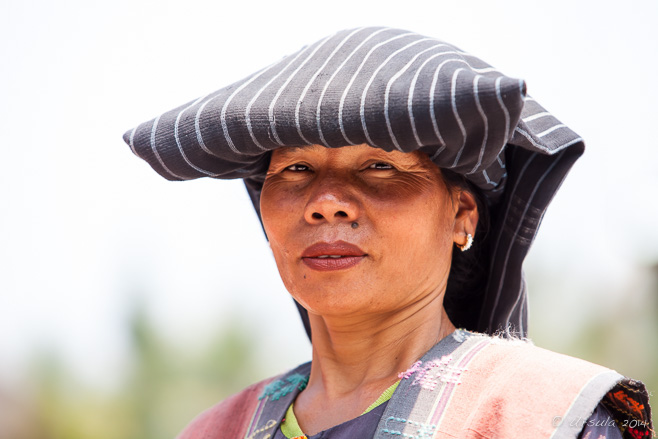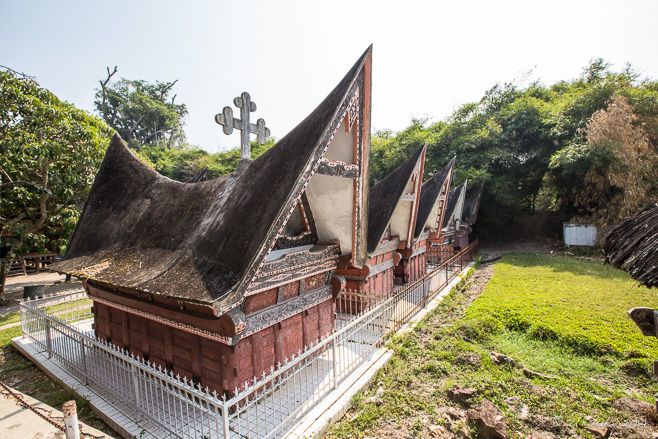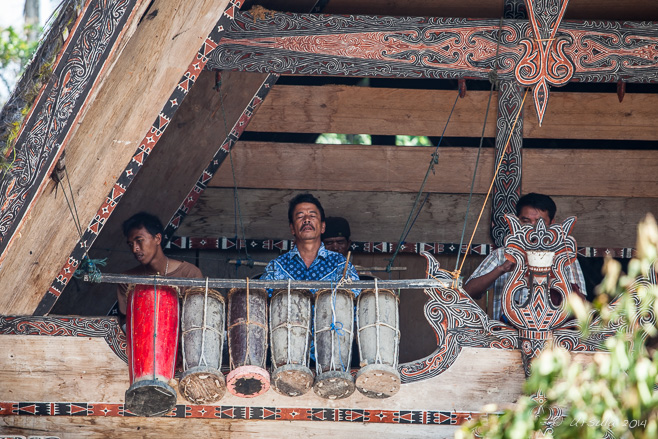
A Toba Batak Woman
How do a people preserve the important values inherent in their culture – more than just a traditional headdress and a signature food – without sacrificing the good things that participating in the modern world can offer?
I often ask myself this when travelling – especially in poorer areas of the world where the people trying to preserve their traditions are not part of the dominant ethnic group.
Samosir Island, a volcanic island in Lake Toba in North Sumatra, Indonesia, is the centre of Batak culture. Descendants of a powerful Proto-Malayan people, the Batak comprise “six (or nine – depending whom you believe) separate groups with different (but related) languages and customs.” The largest of these related groups – and the most culturally distinctive – is the Batak Toba people. Until the arrival of the Dutch in the 1920s, the Toba lived in relative isolation, in the region on and around Lake Toba.
The traditional Batak clan houses, Rumah Bolon, with their elegant saddle-shaped roofs made of thatched sugar palm fibre, are a distinctive sight all around the Batak highlands. Elevated on stilts to protect the occupants against floods or wild animals, these beautiful houses were built without any nails. Some are hundreds of years old. Many are abandoned and falling into complete disrepair. Others have been modified: their old roofs replaced with sheets of corrugated tin. Very few traditional-style houses are being built today – which is why some better-maintained examples of the old styles have been preserved as cultural museums.
The Huta (Village) Bolon Simanindo, once the home of Batak King Raja Sidauruk and his 14 wives, was restored and opened to the public as a museum in 1969. The museum houses a royal boat and a small collection of tapestries, cooking utensils, masks and weaponry.
The real drawcard for tourists, however, is the daily cultural dance performance. While pluralistic religions are not recognised by the state, and most Toba these days are Christian, the dances illustrate some of the old Animist traditions that are still alive and well.

Graves of the Royal Family
The Bataks have a long, proud tradition. Hulon Bolon Simanindo, or Bolon Simanindo Village, was once the home of Batak King Sidauruk and his 14 wives. The family’s royal tombs sit at the entrance to village, which is now a little museum dedicated to preserving and sharing Toba Batak culture.

Toba Batak Musicians
Toba are said to be capable musicians. Traditional music greets us as we enter the village courtyard in time for the daily dance performance.

Toba Batak Dancers
The “villagers” enter the courtyard, leading a buffalo which plays a key symbolic role in the traditional cultural practices.

Courtyard
Toba Batak houses stand side by side, with their front gables facing the village courtyard or street. The pole the buffalo is tied to is a Borotan, a ritual slaughter pole, decorated with leaves to represent the tree of life: the Banlan.

Toba Batak Man
We have been given notes, telling us what the dancers are doing: …

Hair and Headdress
… mostly, they are offering ritual prayers to the god(s), asking that the buffalo behave well, so that participants will be granted sons, daughters, wealth and health.

Ritual Offerings

Buffalo on the Borotan Slaughter Pole
Once the buffalo is slaughtered, the meat will be shared.

Gondang Siboru
In one number, only the women dance – hoping that one of the men will propose to them.

Young Couple
One couple pairs up and dances together. Of course, it is hard to ignore the fact that most of the dancers are quite old – and probably married already. One has to wonder how well the old traditions will carry forward.

Gondang Pangurason
The spirit of an ancestor comes and possesses one of the dancers…

Blessings
… who then blesses th0se gathered with Holy Water.

Dancing Tourists
The tourists are then loaned festive shoulder cloths (kain pelangi) and invited to dance a few rounds.

Magician
In the Tor Tor Tunggal Panaluan dance …

Magician
… the performer is communicating with the gods, making a specific request for the community.

Sigale Gale
The last dance features a wooden marionette, who in this case represents the dead son of the king. There are several stories about the meaning of these wooden effigies, but the common thread seems to be that it is bad luck to die childless, so a symbolic “child” is needed to avert misfortune.

Toba Batak Woman

Toba Batak Woman

The Royal Boat
The decorations on the boat – as on the buildings – are in the traditional Batak colours of red, signifying zest for life; black symbolising death; and white, representing the holy spirit.

Dancing Masks
In the old days, wooden masks assisted dancers to tell important stories.

King’s Tomb
As we leave the museum, we once again pass the tombs of the king and his family. As ornate as these tombs might seem, they pale in comparison with the many costly and opulent mausoleums all over the island – usually much more lavish than the houses that the living are relegated to! Being seen to honour one’s ancestors is still incredibly important.
It was impossible to tell from the dance performance how much of the old traditions are “lived” – rather than just put on display for the tourists. According to Wikipedia, the Toba Batak people maintain distinct aspects of their language and culture, even when they move away from the Toba region.
 They are reputed to be confident and outspoken: characteristics which should stand them in good stead as they move into the future while maintaining some traditions from the past.
They are reputed to be confident and outspoken: characteristics which should stand them in good stead as they move into the future while maintaining some traditions from the past.
Till next time!
Photographs: 19February2014


























.png)


Always a pleasure to travel the world through your eyes, Ursula.
Always lovely to have your company, Melissa. 😀
I am always amazed at how much we do on our short side trips and how educational they are. Good piece.
We ARE pretty lucky!